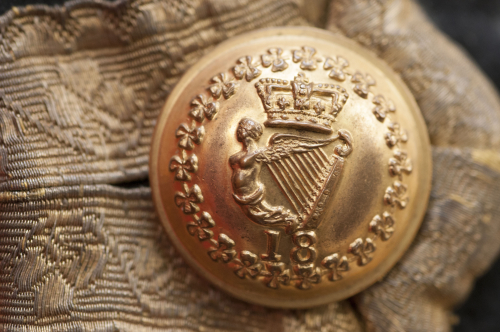
Irish regiment’s doctor’s ‘kindness’ recalled in Napier

Safely stored among the collection of the Hawke’s Bay Museums Trust, is Dr William Isaac Spencer’s 18th Royal Irish Regiment officer’s tunic. This red tunic is beautifully embroidered in gold thread and fastened with gilt buttons, each stamped with the Regiment’s insignia – a winged female supporting the Irish Harp (Harp of Erin) surmounted by the Imperial crown.
The Second Battalion of the 18th Royal Irish Regiment of Foot (nicknamed Paddy’s Blackguards) was formed in 1858 and a year later consigned to England.
At the request of New Zealand’s Governor Grey, the Regiment, along with detachments from the 43rd, 50th and 68th regiments, totalling 3000 soldiers, were dispatched to Aotearoa. Most of the Second Battalion boarded the Elizabeth Anne Bright at Portsmouth on 2 April 1863, arriving in Auckland three months later.
During the New Zealand Wars, Dr Spencer’s regiment was involved in military action at Waikato and Whanganui. In April 1864, they fought at Ōrākau (near Te Awamutu), where an estimated 160 Māori died, along with 17 British soldiers and a further 51 wounded. Lieutenant Colonel Carey wrote:“The wounded received the greatest possible attention on the field from the senior medical officer, Dr White, 65th Regiment, ably seconded by Assistant-Surgeon Spencer, 18th Royal Irish.” Further commendations regarding Dr Spencer’s surgical skill were recorded when “the warrior Tepene Ti Waru, taken prisoner at Ōrākau, had his left arm amputated by Dr Spencer.”
In early 1865, seven companies of the 18th Royal Irish Regiment arrived in Whanganui where they were stationed for over two years, mainly in charge of the military posts securing the road between Whanganui and Pātea. Dr Spencer featured again in official reports, when Forest Ranger Gustavus von Tempsky, “immediately sought out Doctor Spencer, a highly respected and clever doctor attached to the 18th Regiment and begged him to take over the care of (one of his men) who, after a bad bout of the disease, did recover.”
In November 1867 six companies of the Royal Irish left Whanganui - four departed for Auckland and two for Napier. The Hawke’s Bay Times recorded that Whanganui bemoaned their departure which would be “a loss to storekeepers … in particular the beer trade which will be materially affected and suffer most.”
The steamship Ahuriri arrived at the Iron Pot wharf on 17 November, “having on board two companies of the 18th under orders to be stationed at Napier.” The detachment consisted of several officers, including Spencer, along with 129 non-commissioned officers and privates. Seventeen women - one of whom was Anna, Dr Spencer’s wife - and forty-four children accompanied the detachment. On arrival the Regiment marched up Main Street to the Gore Browne Barracks on Mataruahou / Bluff Hill where they were stationed for the duration of their stay.
The Regiment was “compelled by Imperial Orders” not to “to be employed in hostilities between colonists and natives.” They were instructed instead to protect the area, so pickets were sent out daily and “strong and efficient” nightly patrols conducted. The Regiment assiduously practiced their musketry skills, putting up military butts on Marine Parade’s foreshore.
Despite being made to “chafe in the barracks”, the regiment very quickly became involved in community affairs: helping with harvesting, as there was a “scarcity of labour and farmers were anxious to get their crops in”, cleaning up Napier cemetery from a “mass of undergrowth which had crept over graves” and their excellent band performed regularly, “a treat looked for and heartily enjoyed by the lovers of harmony in our midst.”
Again, Dr Spencer’s surgical expertise was noted. Provincial Surgeon, Dr Hitchings, reported to the Hawke’s Bay Provincial Government, “that the boy Robert Willis, whose shoulder was completely denuded (by machinery), the arm only hanging by a single tendon … has since got completely well, the arteries at the time being promptly secured by the timely arrival of my friend Dr Spencer.”
On 6 July 1869 General Chute ordered the 18th Royal Irish Regiment to leave Aotearoa’s shore. The influential men of Hawke’s Bay determined to hold two farewell dinners in the Regiment’s honour, (one for the officers and the other for non-commissioned officers and privates) such was the “universal feeling of esteem and respect”, which the “uniformly good conduct of the men” evoked.
During speeches at the officer’s ceremony, Dr Spencer was described as “a gentleman who while in Napier had performed innumerable acts of unostentatious kindness, and who … would be greatly missed after his departure.”
On Wednesday 19 January 1870, the 18th Royal Irish Regiment stood at attention in front of the Gore Browne Barracks. They then marched in formation “through the town, up Shakespeare Road to the Spit” accompanied by the music of the Napier Brass Band. The embarkment was “managed with great expedition … and the utmost order and regularity.” In fact, it was noted, that not a single soldier was seen intoxicated or performing an “irregularity of any kind.” Once at the Spit the soldiers boarded HMS Virago, which set sail for Wellington, reuniting the Napier contingent with the remainder of the Second Battalion and from there they left Aotearoa’s shores permanently, bound for Australia.
However, 18 men chose to be discharged, ten of whom settled in Napier, including Dr Spencer. Many Napier locals, desperately seeking a second doctor, had encouraged him to resign his army commission and take up private practice in Hawke’s Bay. Although no longer affiliated to his Regiment, Dr Spencer acted as surgeon for the Hawke’s Bay and East Coast Militia.
Published in the Hawke’s Bay Today newspaper on 21 October 2023 and written by Gail Pope, Social History Curator at MTG Hawke’s Bay.
Image: Gilt button from Dr Spencer’s 18th Royal Irish Regiment officer’s tunic, circa 1860
25 October 2023



